We recently had someone purchase black yarn, only to be disappointed it wasn’t the traditional dark black that they were expecting. While the product photo didn’t represent a consistent true black color, it was the expectation of the buyer because the product was labeled as “black”.
For most commercially available goods that are dyed with chemicals, black is black. But in the land of alpacas and their natural colors, black can mean many things. This is especially true when alpaca fiber is run in small batches on a per animal basis.
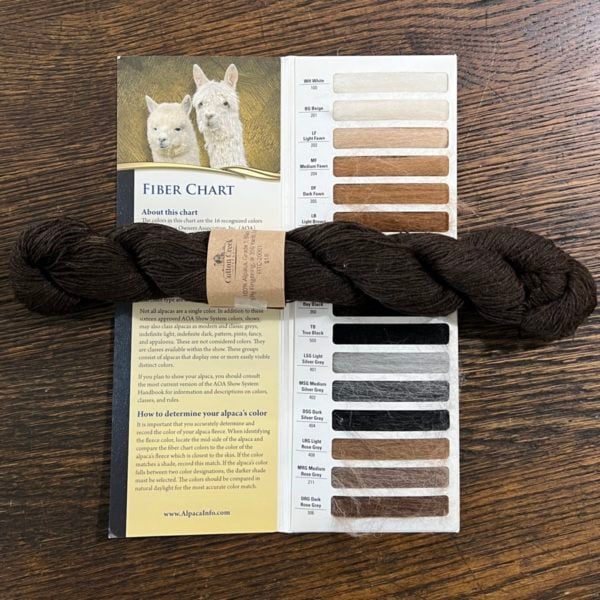
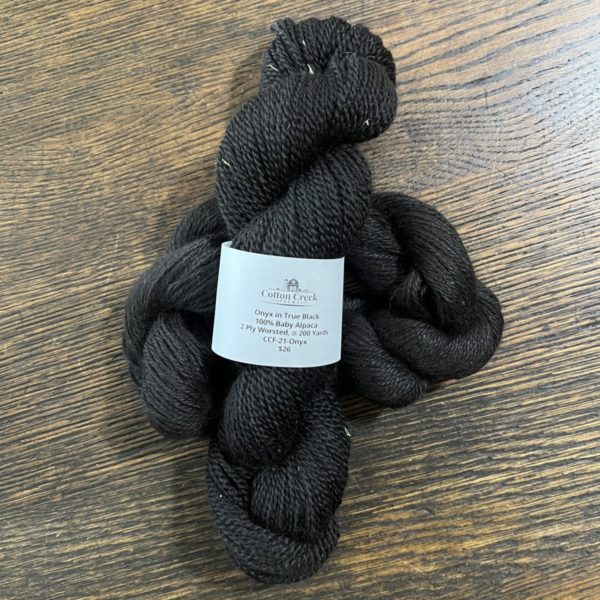
For those experienced with alpaca and its natural color variations, this is not an issue. Many find this natural variation beautiful. For those who expect a more synthetic, uniform color, it can be concerning.
After talking to this buyer in email, I thought it would be helpful to review the primary colors of alpacas, the variations that can occur, and explain why these color variations exist. This might help others who are searching for and buying alpaca yarn or alpaca products.
Official Alpaca Colors and Approved Show Classifications
The Alpaca Owners Association (AOA) recognizes sixteen primary alpaca colors that including white, beige, light fawn, medium fawn, dark fawn, light brown, medium brown, dark brown, bay black, true black, light silver grey, medium silver grey, dark silver grey, light rose grey, medium rose grey, and dark rose grey.
The association also notes that not all alpacas are a single color and the AOA approved shows must account for this as they classify alpacas into color groups for showing purposes. These additional color variations expand our core sixteen colors to also include modern grey, classic grey, indefinite light, indefinite dark, pattern, pinto, fancy, and appaloosa.
It is important to note that the AOA does not specifically call these additional variations out as true alpaca colors. Instead, they are classifications that the association can use to best group alpacas for the show circuit.
Color Variations Complicate Matters Further
While we know there are sixteen recognized colors and eight additional classifications, the color of an alpaca is further complicated by factors such as colored fiber tips, dark trim, cria coats, color overlays, sun bleaching, uniformity, and contamination.
When an alpaca is born the first fiber produced is what we call the cria coat. The cria coat at birth is generally not the true color of the alpaca. The reason for this is the amnionic fluid will alter the true color while the baby grows inside the dam (mother). Once the baby is born and the alpaca fiber begins to grow, we will be able to see the true fiber color. If you use this cria coat (first shearing) for the creation of yarn or products, you will get a color slightly different than the alpaca’s mature color. This is because the cria fiber tips will mix in with the main fiber color to produce a slightly different hue.
Other alpacas will have natural fiber tips that are different than the color of fiber at the base. A common example of this would be a black fiber with brown tips.
Another example would be alpacas that have dark trim. We have multiple alpacas that have brown fiber coats with black mixed into key areas of the body such as the eyes and nose.
Just the opposite is also true. You can have a black or brown alpaca with a light overlay that looks like shading within the fiber. Adel was the first baby on our farm, and she is a light fawn with dark fawn spots. To make matters more complicated, her fiber color has an overlay. Her fiber ranges from light fawn to medium fawn, then you throw in her dark fawn spots. And what happens when you spin yarn from this type of coat? You end up with a yarn skein that isn’t light, medium, or dark fawn. It has a unique color. And, while I think this demonstrates the beauty of nature, a commercial processor would reject Adel’s fiber for its lack of uniformity. Below is a photo of Adel’s yarn next to Ollie’s yarn. Both are considered light fawn.
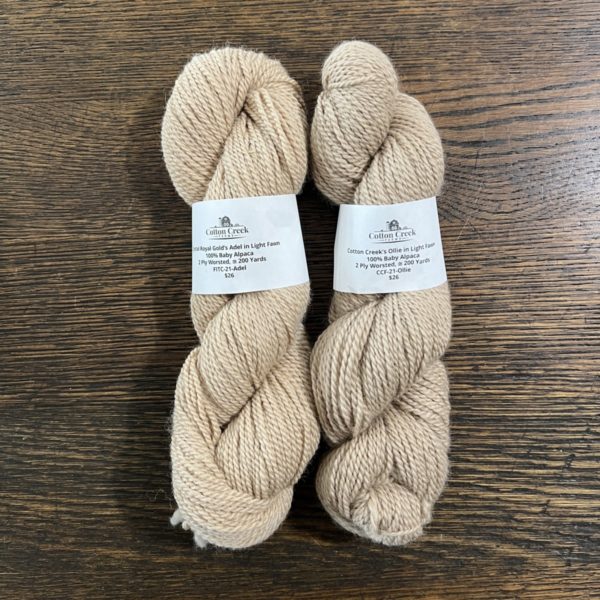
An interesting fact about alpaca fiber is that some alpacas can have their fiber color bleached in the sun. This doesn’t happen to all alpacas, but it does happen to some of the fiber coats. This bleaching doesn’t hurt the fiber or hamper the final product produced. What it will do is take a true black or bay black fiber coat and push it into a more brown coloring. The fiber is still considered black, however, the black isn’t the same color black you’d expect to see in a commercially dyed product. It becomes its unique shade of black.
Another popular trend on our farm is the indefinite fiber coat. Vicki Grey Butt, officially known as Virtuosity, received her nickname because she is a dark silver grey alpaca with a lighter grey butt. We bought her specifically for this more unique coloring. Vicki was registered with the national association as a dark silver grey, but when shown at the Buckeye Fall Fest she was placed in the indefinite color group. Vicki’s sire (father) is Snowmass XXXtreme Legacy XXX, and he is known for producing alpaca of color and particularly alpacas that would fall within the indefinite color category. Does this indefinite degrade the value of an alpaca? Not really. Daisy is one of our female breeders and she gave birth last year to a daughter named Snowmass Iron Maiden. Iron Maiden is registered as dark silver grey, but she is truly an indefinite. She sold at auction this week for $25,000+. And from that number, we can truly see that her indefinite fiber coat did not hamper her value.
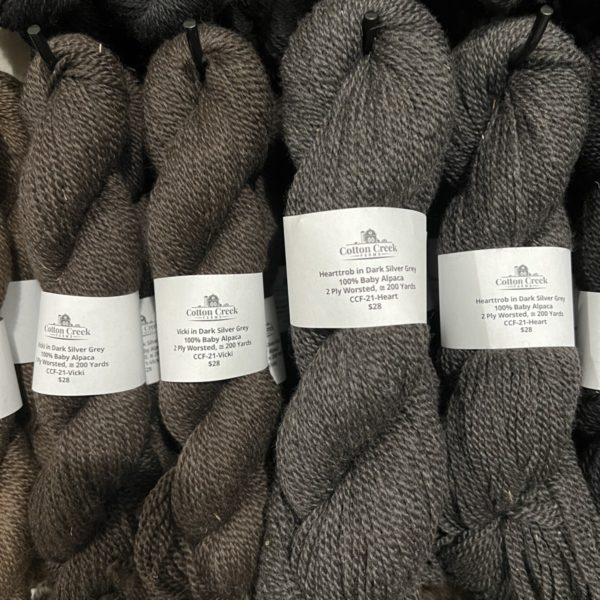
And finally, we come to contamination. Contamination is when you have an alpaca fiber blanket of one color, but there are random hairs mixed in of another color. If you are in the commercial fiber business, this would be the death of your business. If you’re an alpaca on our farm, we accept it because our fiber gets processed at cottage mills and this contaminated color will get mixed in with the primary color to create a unique shade of yarn.
And what about patterns? Jalapena, Sherry Ann, and many other alpacas on our farm possess amazing color patterns. Sherry Ann has bright white fiber that is soft and full of luster and crimp. Mixed into her fiber coat are very large fawn spots. When you mix Sherry Ann’s colors together in processing, she produces a light fawn yarn skein. We love it and so do our farm store visitors. Sherry Ann’s hats started selling the day I put them into stock.
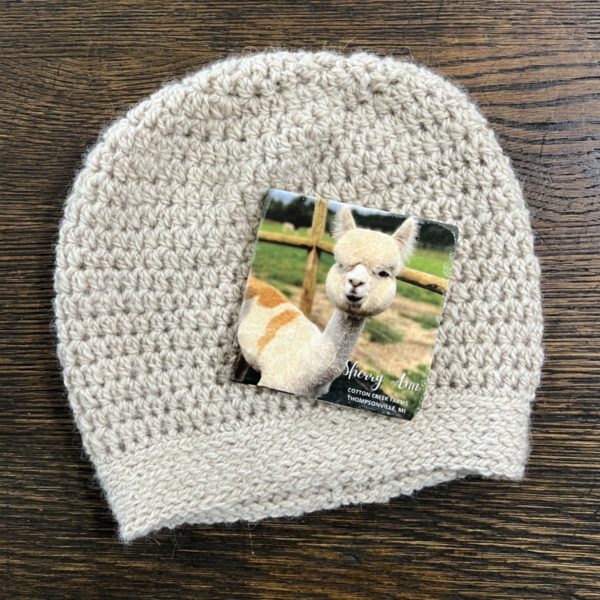
If You’re Not Sure, Ask Before You Buy
If you’re buying your first alpaca product or skein of alpaca yarn, look carefully at the product images before purchase. There are many variations of white, black, fawn, and other colors so if you’re not sure if the color is what you want, inquire via the website before purchase, or if possible, visit the store in person.
Most shop owners won’t mind sending you additional product pictures, answering questions, or suggesting an alternate product for your needs. They’d much rather you take this approach because it will help you validate you are buying the right product.
It’s All Beautiful to Us
As we saw in the case of Snowmass Iron Maiden mentioned above, color can be beautiful. She didn’t sell at auction solely due to her color, but it did help her stand out. And to us, such coloring is to be celebrated.
Our farm embraces uniqueness and we encourage variety. In our agritourism business, the tour attendees and store shoppers do too. This is especially true if the shopper first met the alpaca in person, fed it, and took selfies with it.
Whether you want a bright white hat made from Dolly, rich dark grey yarn made from Heartthrob, or a unique reddish-brown set of mittens from High Velocity, you’ll find it at our farm and in our store.
I love watching the alpacas get sheared and knowing their fiber will be turned into amazing products. It takes all my beloved fur babies and converts their fiber into products that are eco-friendly, sustainable, hypoallergenic, super soft, and extremely warm. It’s a good, fiber-rich life.

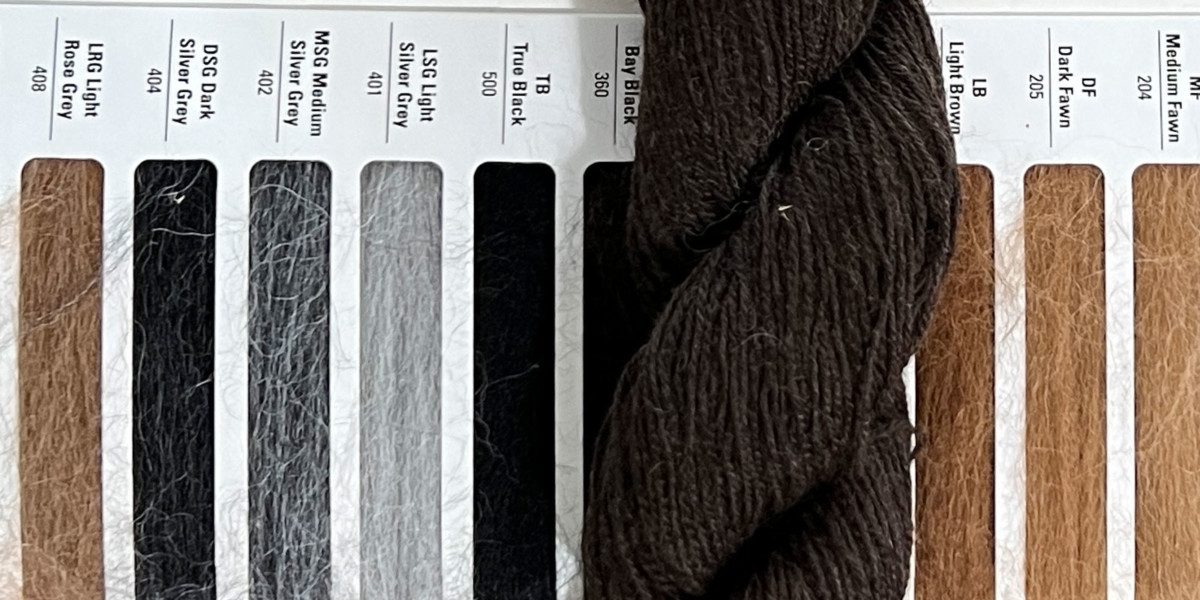

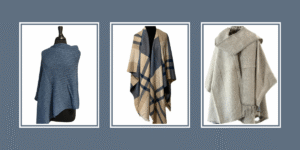

Can one use alpaca fur to make fur coats and hats? Does it lend itself well to just having the fur laying soft and straight light a mink jacket or coat? How would it be different from mink?
Anne there are coats and hats made out of alpaca fiber and we offer fur hats in our online store at https://cottoncreekfarms.com/store/product-tag/fur-alpaca-hats/. Coats are harder to come by due to the mass of fur required and the cost to produce.
The fur would most likely be shorter and soft, so it would lay nicely for wear.
The one thing to note on these items is they are in limited supply because we (as an industry in the USA and Peru) do not harm alpacas to harvest fur. Alpacas are sheered annually for their health and this is done without harm, however, you cannot use this output for fur coats and hats.
The fur used for hats and coats come from alpacas that have naturally passed away and this would mean they pretty much all originate from the small farms in Peru where they have a much higher mortality rate than what we do in the USA. In the USA we have shelter, oodles of hay, and we tend to overcare for our animals. That is not an option in Peru, and while these small farms take good care of their herds, their more limited food sources and higher rate of natural diseases produce a much higher rate of death. These lost animals have their fur blankets used for these goods so the farmers can at least salvage something from the loss.
I cannot speak for other locations, such as China, where the alpaca industry is growing. So if you do purchase these fur goods, please make sure you know where they originate and that no animals were purposely harmed in the process.
I am planning an afghan for my 18 year old grandson. He likes shades of black and gray. It os a rather large afghan in the randw of 50 x 72. I will need around 40+ skeins . The design flows from dark to light. I am wondering if you would have the range of colors available now? Thank you so much. Sally Doran
Sally if you’re pattern calls for worsted weigh yarn we would have oodles available. Can you confirm if worsted is what you are looking for? If so, I can email you links to the right yarn options.